Every year, we give over all of December (and usually most of January) to a series called ‘Shadows and Reflections’, in which our contributors share highs, lows and oddments from the past 12 months. Today it’s the turn of Nancy Campbell.
The Most Precious Sap
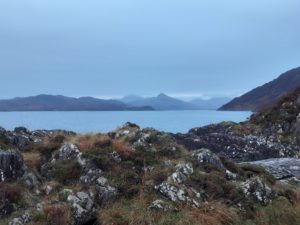
Loch Nevis
A grey heron stalks across the pale sand, each step incremental as the ripple of the tide. At the mid-point of the bay’s arc it pauses.
Rain has been falling steadily for two days. Water infuses the light here, and seeps into the soundscape of the croft, chattering on the bothy roof and rilling down hillside to the shore. There’s a loaf of rye bread in the cupboard from the harbour bakehouse and coffee on the stove, and the bothy — unlike my caravan — has welcome heating and hot water.
Now the heron stands on a rock, its beak pointed towards the blue blur of the Knoydart peninsular on the horizon. I wonder what its binocular vision reveals. I am not fluent in this landscape. I must learn what to observe by watching the observations of others. This morning the heron is my teacher. The light on the loch changes: white waves on dark water become dark waves on light water. After an hour of stillness, the bird glides back across the bay.
A heron will do this, over and over, after I have gone.
*
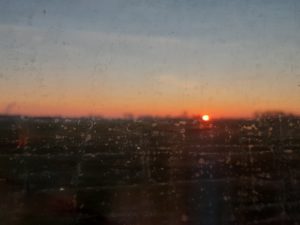
London to Paris
This year I began to travel again. I chose as my destinations long overdue returns rather than new journeys, pilgrimages to landscapes l had missed. For the last three weeks, trains have taken me across Germany from south to north, under the sea, then up the east coast of England, and from the debatable lands on the border of Scotland where I grew up to the Highlands. Mallaig is the final stop on the line from Fort William, but an ending is always a beginning and there’s a harbour here from which you can take a ferry on to the islands.
But I’ve come here to pause. ‘If we think of space as that which allows movement, then place is pause,’ wrote the venerable geographer Yi-Fu Tuan, who died earlier this year. ‘Each pause in movement makes it possible for location to be transformed into place’ (Space and Place: The Perspective of Experience).
The painter Jane Rushton shares this place with the heron. She’s not the first artist to live here on Loch Nevis: in the 1950s, John Schueler came from New York and honed his Abstract Expressionist vision in the small whitewashed house at the top the track. He returned many times until the 1970s. When I was last here — it must be five years ago at least, before Jane and Mike built the bothy — it was to interview Jane; I’d been commissioned to write a profile on her work.
On that previous visit, Mike was regenerating the croft’s natural woodland with birch, rowan, oak, and willow. Mike, who is no longer here, yet a strong presence still — loved and remembered. The saplings have grown braw against the hillside. The woodland will be managed this winter, excess trees removed in order to allow others more light, and habitats for birds, small mammals, and a variety of ground flora, mosses, and lichens.
Yesterday evening, Jane cooked fish fresh from the loch and opened a bottle of wine. We talked again about her work and mine, our travels in Greenland and mutual friends there, about questions of scale — the vast Arctic tundra and wormholes of deep time. We exchanged quiet thoughts on how our practices shifted during loss and lockdown, on striving to find a way forward through personal grief and solastalgia.
*
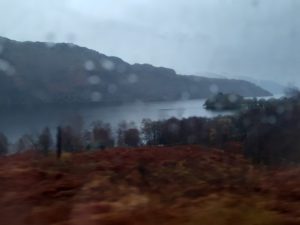
Fort William to Mallaig
As the ScotRail train rattled through the mist across Rannoch Moor I’d begun reading a book a friend in Munich had given me. The kind of book you want to tell people about, and even pass on. Mark has underlined sentences and made exuberant marginal notes. Reading the book is like continuing a conversation with him. It speaks to me at a time when words don’t come easily, when I’ve found it difficult to make small talk or even turn up at my desk.
I want to tell Jane about this: how The Tree suggests new ways of seeing nature, makes the case for allowing the world its “namelessness” rather than subjecting it to a human taxonomy. The author, John Fowles, writes: ‘this namelessness is beyond our sciences and our arts because its secret is being, not saying.’
Being, not saying. Like sitting in a bothy in the rain.
Nature is not outside us, Fowles writes: ‘this being can be apprehended only by other present being, only by the living senses and consciousness. All experience of it through surrogate and replica, through selected image, gardened word, through other eyes or minds betrays or banishes its reality. … It can be known and entered only by each, and in its now; not by you through me, by any you through any me; only by you through yourself, or me through myself. We still have this to learn: the inalienable otherness of each, human and non-human…’
*
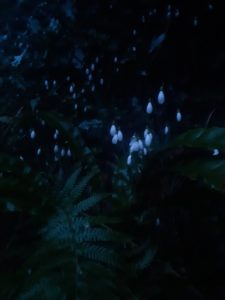
Snowdrops at Hawthornden
In February I was awarded a month-long fellowship at Hawthornden in Midlothian. My first residency since becoming a carer during lockdown — how would I find my working rhythm again? Time within the castle walls is time offline. The hours were kind to me. I read visionary accounts of the cycle of the seasons: Charlotte Du Cann’s After Ithaca, Joan Didion’s Year of Magical Thinking, Tanya Shadrick’s The Cure for Sleep. These books offered eerie parallels with my own days, and I saw them as magical manuals which might teach me better how to be. Many paragraphs I read more than once, and I copied passages into my journal. I read Lulah Ellender’s Grounding, a magnificent memoir which explores human time as well as garden time, its sweep forwards and backwards exploring the memories we inhabit while planting for the future.
I struggle to find my thread in the minotaur’s labyrinth of Twitter when I return to 5G and the world of gardened word, of betrayals and banishment. Nature, as Fowles writes, ‘cannot be reproduced.’
The controversial takeover of Twitter means I can’t take for granted what data I give away, how it is used and by whom. What is the hidden cost of promoting my work and the causes I hold dear? In what interests is my voice complicit? I have experienced devastating abuse on this platform, as well as more joyful encounters. I decide to be circumspect, and delete my account.
‘Scientists speak of biological processes recreated in the laboratory as being done in vitro; in glass, not in nature,’ Fowles wrote in 1978, the year I was born, using a register that sounds now a little formal and thus remote. ‘The evolution of human mentality has put us all in vitro now, behind the glass wall of our own ingenuity.’
*
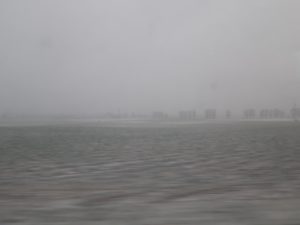
Munich to Berlin
At a poetry festival set among shipping containers in the east end of Munich, I read from my new book Uneasy Pieces. It is wonderful to be performing live, to be alive, to be gathered in the same room with other writers — Jessie Kleeman from Greenland, Mihret Kebede from Ethiopia, Don Mee Choi from Leipzig.
I return to Bamberg, my home for a year before the pandemic. Old cafes have been refurbished, wooden chairs replaced by fibreglass. The city seems shrunken, a miniature model of itself. Or maybe I made it grow, with my longing. As I retrace my walks by the river Regnitz I imagine Bamberg’s citizens pounding the Milchweg, the Muhlworth during lockdown, just as I walked by the river Thames.
As Marilyn Hacker writes, ‘As you leave the place, you bring / the time you spent there to a closed parenthesis… / You take the present tense along’ (‘Essay on Departure’).
A memory of a misty dawn in February 2020, the day I was due to return at last to Oxford: I stood on the balcony watching bicycles with bright headlights bump along the path between the linden trees leading to the bathing place, and over the cobbles of Muhlworth comes a slim young monk, alone, his towel neatly folded over his arm, and he makes his serious progress along the riverbank, then just before he disappears from view behind the yellow stone of the Villa Concordia, he pauses to blow his nose. At that moment, out of the linden trees comes another monk of similar age and stature — and of course dressed the same — and, as the first monk vanishes the next approaches the corner of the Villa, and I turn away from the window, but now I cannot help imagining an endless flow of acolytes, and I feel like a monk, too, a solitary clone also about to disappear, all too aware that another writer will soon inhabit my rooms in the Villa, and attempt to order language at this same desk.
I find leaving harder now. Too many goodbyes on station platforms. Too many brief pauses in places you believe you could love, but for the necessity to keep moving. Too many people you may never see again. Parenthesis. Full stop.
*
“Coming back,” Jane says, “you know a place better, you make deeper incursions into the landscape. Like a tree, branching out.” She is thinking of Greenland, I know. But as she speaks, I remember the trees behind the bothy, the birch, the holm oak, that Mike planted in the croft’s spare soil.
For John Fowles the tree symbolised the wild in the human psyche which found its way into fiction. How difficult he found it to describe. A tree has ‘such inturned peace, such profound harmlessness, otherness, selflessness, such unusing…all words miss, I know I cannot describe it.’ He believed in the importance in art of the unpredictable, the unaccountable and the intuitive. ‘The wood waits, as if its most precious sap were stillness.’
The Tree begins in the orchard Fowles’ father carefully cultivated, and ends in Wistman’s Wood, ‘an infinitely rare fragment of primeval forest’ on Dartmoor. ‘It is the silence, the waitingness of the place, that is so haunting,’ he confesses. ‘A pastness, a presentness, a skill with tenses the writer in me knows he will never know; partly out of his own inadequacies, partly because there are tenses human language has yet to invent.’
*
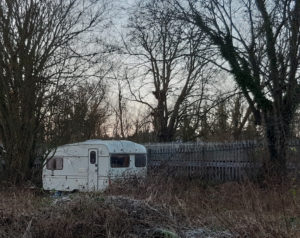
I return from all these returns to my caravan by the canal. I walk through the wicket gate and my wheeled suitcase, which has covered so many miles with me, feels incongruous and inadequate on this homely mud.
Several trees have been felled.
The picnic table is covered in junk: a can of WD40, a plastic dog poo, a bonsai maple, some suet crumbs and an assortment of screws. Instead, the assassin and Aislin are hunched over a huge tree stump, eating their lunch. The assassin boils the kettle and sets down a mug of Earl Grey for me on the rotten wood. I dig out a festive stollen from my bag. They offer me rice cakes. We talk about the trees, and they tell me how one willow blew down in the storm and then others had to go: a hard decision when many are still greenwood yet unsafe. But there is room for new growth in the absence of the old canopy.
“How’s the roof going?” I ask.
Without a word the assassin leads me round the back of the half-finished barn. A building at its beginning is the opposite of a ruin. A steel ladder is leaning against the brickwork, and he starts to climb. “Put your bags down,” he says. “You won’t need them.” The ladder is roped to another ladder which is roped to another ladder. It ascends about fifty feet to the ridge, where he has been working on the rafters. “Come on then,” he says.
I put the smooth sole of my smart boot on the first rung, and follow. When I reach the eaves, there’s a timber platform, then another ladder to the ridge. I scramble onto the highest point — it feels like a game of musical chairs after the chairs are removed — aware my standing frame is more precarious here than it is on the ground. The slightest wind could blow me down. I can see the picnic table below, our tiny doll-house mugs on the stump.
“Look!” the assassin says. He points, directing my eyes not down, but outwards, and on across to the canal, the wide meadow, and over the railway tracks to the lakes. North, beyond the overpass. He turns a complete circle. I can see my caravan, empty and waiting for me all these weeks, at the far side of the newly cleared woods. “Welcome home,” he says.
*
John Fowles’ ‘The Tree’ was published in paperback by Vintage in 2000 — Nancy has just caught up with it. Nancy’s memoir ‘Thunderstone’ was reviewed by Kerri ní Dochartaigh for CBTR this summer. ‘Uneasy Pieces’ is available from Guillemot Press.